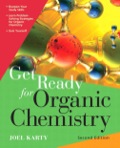
EBK GET READY FOR ORGANIC CHEMISTRY
2nd Edition
ISBN: 8220100576379
Author: KARTY
Publisher: PEARSON
expand_more
expand_more
format_list_bulleted
Concept explainers
Question
Chapter D, Problem D.2P
Interpretation Introduction
Interpretation:
The orbital interaction that illustrates the most significant hyperconjugation interaction in
Concept introduction:
The HOMO is the highest occupied molecular orbital. If the HOMO and LUMO orbitals can interact, then the interaction stabilizes the entire species. The species that contribute to the pertinent HOMO in the interaction is relatively electron-rich. It is the Lewis base or the nucleophile. The species that contribute the pertinent LUMO is relatively electron-poor. It is the Lewis acid or the electrophile.
Expert Solution & Answer
Want to see the full answer?
Check out a sample textbook solution
Students have asked these similar questions
Choose the Lewis structure for the compound below:
H2CCHOCH2CH(CH3)2
HH
H
:d
H
H
H C.
Η
H
H
HH
H
H
H
H.
H
H
H
HH
H
H
H
H
H-
H
H
H
C-H
H
H
HHHH
Each of the highlighted carbon atoms
is connected to
hydrogen atoms.
く
Complete the reaction in the drawing area below by adding the major products to the right-hand side.
If there won't be any products, because nothing will happen under these reaction conditions, check the box under the drawing area
instead.
Note: if the products contain one or more pairs of enantiomers, don't worry about drawing each enantiomer with dash and wedge
bonds. Just draw one molecule to represent each pair of enantiomers, using line bonds at the chiral center.
More...
No reaction.
Explanation
Check
O
+
G
1. Na O Me
Click and drag to start
drawing a structure.
2. H
+
2025 McGraw Hill LLC. All Rights Reserved. Terms of Use | Privacy Center | Accessibility
000
Ar
P
Chapter D Solutions
EBK GET READY FOR ORGANIC CHEMISTRY
Ch. D - Prob. D.1PCh. D - Prob. D.2PCh. D - Prob. D.3PCh. D - Prob. D.4PCh. D - Prob. D.5PCh. D - Prob. D.6PCh. D - Prob. D.7PCh. D - Prob. D.8PCh. D - Prob. D.9PCh. D - Prob. D.10P
Ch. D - Prob. D.11PCh. D - Prob. D.1YTCh. D - Prob. D.2YTCh. D - Prob. D.3YTCh. D - Prob. D.4YTCh. D - Prob. D.5YTCh. D - Prob. D.6YTCh. D - Prob. D.7YTCh. D - Prob. D.8YTCh. D - Prob. D.9YTCh. D - Prob. D.10YTCh. D - Prob. D.11YTCh. D - Prob. D.12YTCh. D - Prob. D.13YTCh. D - Prob. D.14YTCh. D - Prob. D.15YTCh. D - Prob. D.16YT
Knowledge Booster
Learn more about
Need a deep-dive on the concept behind this application? Look no further. Learn more about this topic, chemistry and related others by exploring similar questions and additional content below.Similar questions
- Draw a tetramer of this alternating copolymer.arrow_forwardH I T H HH H -H C. H- Identify and select all structures below that represent a constitutional isomer(s) of the compound shown above. H- H CIH H H H HHHH H H 0 ·H H– 冊 CH CHI HH C- H- H H- H H A. H H C H H- -H HH H B. H- -H D. H H H H • H -H E. -H H H HICH T HHH F. H-arrow_forwardPolylactic acid (shown below) is a biodegradable polymer used for food packaging. Identify the monomer(s) used in the production of this polymer using a condensation process.arrow_forward
- Draw the product of the reaction shown below. Ignore small byproducts that would evaporate pleasearrow_forwardPoly(ethylene adipate) is a biodegradable polyester (shown below). Identify the type of polymerization process used in the production of this polymer.arrow_forwardPolymers may be composed of thousands of monomers. draw two repeat units(dimer) of the polymer formed in this reaction. assume there are hydrogen atoms on the two ends of the dimer. ignore inorganic byproducts pleasearrow_forward
- Draw the product of the reaction shown below. Use a dash or wedge bond to indicate stereochemistry of substituents on asymmetric centers, Ignore inorganic byproductsarrow_forwardDraw the product of this reaction please. Ignore inorganic byproductsarrow_forwardOne of the pi molecular orbitals of 1,3-butadiene (CH2=CHCH=CH2) is shown below. Please identify the number of nodal planes perpendicular to the bonding axisarrow_forward
- Draw the monomers required to synthesize this condensation polymer please.arrow_forwardProvide the correct systematic name for the compound shown here. Please take into account the keyboard options belowarrow_forwardcurved arrows are used to illustrate the flow of electrons. using the provided starting and product structures, draw the curved electron-pushing arrows for the following reaction or mechanistic step(s)arrow_forward
arrow_back_ios
SEE MORE QUESTIONS
arrow_forward_ios
Recommended textbooks for you
 Chemistry: Principles and PracticeChemistryISBN:9780534420123Author:Daniel L. Reger, Scott R. Goode, David W. Ball, Edward MercerPublisher:Cengage Learning
Chemistry: Principles and PracticeChemistryISBN:9780534420123Author:Daniel L. Reger, Scott R. Goode, David W. Ball, Edward MercerPublisher:Cengage Learning Organic ChemistryChemistryISBN:9781305580350Author:William H. Brown, Brent L. Iverson, Eric Anslyn, Christopher S. FootePublisher:Cengage Learning
Organic ChemistryChemistryISBN:9781305580350Author:William H. Brown, Brent L. Iverson, Eric Anslyn, Christopher S. FootePublisher:Cengage Learning
 Chemistry: An Atoms First ApproachChemistryISBN:9781305079243Author:Steven S. Zumdahl, Susan A. ZumdahlPublisher:Cengage Learning
Chemistry: An Atoms First ApproachChemistryISBN:9781305079243Author:Steven S. Zumdahl, Susan A. ZumdahlPublisher:Cengage Learning ChemistryChemistryISBN:9781305957404Author:Steven S. Zumdahl, Susan A. Zumdahl, Donald J. DeCostePublisher:Cengage Learning
ChemistryChemistryISBN:9781305957404Author:Steven S. Zumdahl, Susan A. Zumdahl, Donald J. DeCostePublisher:Cengage Learning

Chemistry: Principles and Practice
Chemistry
ISBN:9780534420123
Author:Daniel L. Reger, Scott R. Goode, David W. Ball, Edward Mercer
Publisher:Cengage Learning

Organic Chemistry
Chemistry
ISBN:9781305580350
Author:William H. Brown, Brent L. Iverson, Eric Anslyn, Christopher S. Foote
Publisher:Cengage Learning


Chemistry: An Atoms First Approach
Chemistry
ISBN:9781305079243
Author:Steven S. Zumdahl, Susan A. Zumdahl
Publisher:Cengage Learning

Chemistry
Chemistry
ISBN:9781305957404
Author:Steven S. Zumdahl, Susan A. Zumdahl, Donald J. DeCoste
Publisher:Cengage Learning